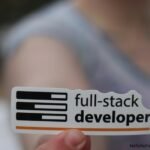Full Stack Development alludes to the act of creating both the front-end (client-side) and back-end (server-side) portions of a web application or programming item. A full stack engineer is somebody who has what it takes and information to deal with all layers of the application stack, from the UI to the data set.
Front-end improvement includes making the visual components of a site or application that clients cooperate with straightforwardly. This incorporates planning the design, carrying out UIs, and guaranteeing responsiveness across various gadgets and screen sizes. Front-end advances generally utilized by full-stack engineers incorporate HTML, CSS, and JavaScript, alongside structures and libraries, for example, Respond, Rakish, or Vue.js.
Back-end improvement, then again, centers around the server-side rationale and framework important to drive the application. This incorporates taking care of solicitations from the client, handling information, connecting with data sets, and overseeing client confirmation and approval. Full stack designers chipping away at the back end frequently use programming dialects like JavaScript (with Node.js), Python, Ruby, Java, or PHP, alongside structures like Express.js, Django, Ruby on Rails, Spring Boot, or Laravel.
Database Management Essentials
- Relational vs. NoSQL Databases
(1) Relational vs. NoSQL Databases
Social information bases and NoSQL (Not just SQL) data sets address two unmistakable ways to deal with overseeing and sorting out information, each with its assets and shortcomings. Here is an examination of the two:
Social Information bases:
Structure:
Social information bases put together information into organized tables comprising lines and sections.
They implement a predefined outline, which characterizes the design of the information and the connections between various tables.
Information Uprightness:
Social information bases stick to Corrosive (Atomicity, Consistency, Separation, Sturdiness) properties, guaranteeing information respectability and consistency.
They support exchanges, permitting different tasks to be gathered and executed molecularly.
Inquiry Language:
Social information bases use SQL (Organized Inquiry Language) as the standard language for questioning and controlling information.
SQL gives a strong and normalized method for connecting with social data sets, making it simple to recover, update, and oversee information.
Adaptability:
Conventional social data sets might experience versatility impediments while managing huge datasets or high simultaneousness.
Scaling social information bases frequently includes vertical scaling (adding more assets to a solitary server), which can become costly and testing to keep up with.
NoSQL Information bases:
Structure:
NoSQL information bases utilize adaptable information models, like key-esteem, archive, section family, or diagram, to store and coordinate information.
They offer outline adaptability, considering dynamic or blueprint-less information structures, which can adjust to advancing application needs.
Information Trustworthiness:
NoSQL data sets might loosen up a few Corrosive properties for execution, versatility, or adaptation to non-critical failure.
Some NoSQL data sets focus on accessibility and segment resistance (CAP hypothesis) over solid consistency, offering inevitable consistency models.
Question Language:
NoSQL data sets frequently have their question dialects or APIs custom-made to explicit information models.
Questioning in NoSQL data sets might require learning new sentence structures or utilizing specific libraries or drivers, contingent upon the picked data set innovation.
Adaptability:
NoSQL data sets are intended for even adaptability, permitting them to proficiently disseminate information across various hubs and handle huge jobs more.
They succeed at scaling out, adding more hubs to a bunch to oblige developing information volumes and client traffic.
Use Cases:
Social information bases are appropriate for applications with organized information and complex connections, for example, conditional frameworks, monetary applications, and customary undertaking programming.
NoSQL data sets are frequently liked for applications with huge volumes of unstructured or semi-organized information, for example, virtual entertainment stages, content administration frameworks, constant investigation, and IoT (Web of Things) gadgets.
Version Control with Git
- Basics of Git
- Branching and Merging Strategies
- Collaboration with GitHub
(1) Basics of Git
Git is a conveyed rendition control framework usually utilized for following changes in source code during programming improvement. It permits different designers to team up on projects, Full Stack Development track amendments, and oversee codebase history proficiently. Here are the fundamental ideas and orders you want to be aware of to get everything rolling with Git:
Storehouse (Repo):
A storehouse is a registry or extra room where your undertaking documents are put away, alongside the correction history.
To make another Git store, explore your undertaking registry in the terminal and utilize the order git init.
Commit:
A commit is a preview of your task’s present status at a specific moment. It records changes made to the documents in the archive.
To commit changes to the store, you first add the changed documents utilizing git add <file> and afterward make a commit utilizing git commit – m “Commit message”.
Branch:
A branch is an equal rendition of your store, permitting you to chip away at highlights or fixes without influencing the principal codebase.
To make another branch, you can utilize git branch <branch-name> and change it with git checkout <branch-name>.
Combine:
Blending consolidates changes from various branches into one branch, regularly the fundamental branch (e.g., ace).
To consolidate changes from a branch into another branch, you change to the objective branch (git checkout <target-branch>) and utilize git combine <source-branch>.
Distant Storehouse:
A distant store is facilitated on a server and fills in as a focal area for teaming up with others.
To interface your nearby storehouse to a far-off vault, Full Stack Development you use git remote add <remote-name> <remote-url>.
Go back and forth:
Pushing includes sending your serious changes from your nearby storehouse to a distant vault.
Pulling includes bringing changes from a far-off store and combining them into your nearby office.
To push changes to a far-off vault, use git push <remote-name> <branch-name>. To pull changes, use git pull <remote-name> <branch-name>.
Status and Log:
git status: Shows the ongoing status of the storehouse, including altered records and arranged changes.
git log: Shows a sequential rundown of commits, showing commit messages, Full Stack Development creators, and timestamps.
(2) Branching and Merging Strategies
Stretching and blending are fundamental parts of adaptation control work processes in Git, empowering groups to team up actually and oversee changes to their codebase. Different fanning and consolidating systems exist, Full Stack Development each fits explicit task prerequisites and group elements. Here are a few normal systems:
Include Branch Work process:
In this methodology, each new component or assignment is created in its devoted branch.
Designers make another branch from the fundamental branch (e.g., ace) for each component they are chipping away at.
When the element is finished, the branch converges once more into the principal branch using a force demand or consolidation demand.
This approach keeps the primary branch perfect and stable while taking into consideration the equal advancement of various elements.
Git Stream:
Git Stream is a stretching model promoted by Vincent Driessen, comprising a few seemingly perpetual branches.
The primary branches in Git Stream are ace (for the creation of prepared code) and produce (for the continuous turn of events).
Highlight branches are made from the foster branch and converged once again into it once complete.
Discharge branches are made from creation to plan for another delivery, considering bug fixes without disturbing continuous turn of events.
Hotfix branches are utilized to rapidly address creation issues, Full Stack Development fan out ace, and converge once more into both expert and create.
GitLab Stream:
GitLab Stream is like the Component Branch Work process yet underlines Ceaseless Coordination (CI) and Constant Sending (Compact disc) rehearses.
Engineers include branches for each new change, and these branches are consequently tried utilizing CI pipelines.
When the element breezes through assessments, it converges into the fundamental branch (frequently named primary or creation).
Discharges are labeled in the principal branch, setting off sending pipelines for creation discharges.
This approach underscores robotization and cooperation, Full Stack Development guaranteeing that all changes are completely tried before being converged into the principal branch.
Trunk-Based Improvement:
Trunk-based improvement advances a solitary, shared code line (trunk or fundamental branch) where all advancement occurs.
Engineers work straightforwardly on the fundamental branch or brief element branches.
Consistent Joining rehearses is pivotal, guaranteeing that changes are coordinated and tried habitually.
This system energizes more modest, Full full-stack development and more successive changes and limits the intricacy of dealing with different branches.
GitHub Stream:
GitHub Stream is a lightweight, branch-based work process intended for straightforwardness and adaptability.
Designers make brief branches for each element or fix.
Changes are surveyed through maneuver demands before converging into the principal branch (frequently primary or expert).
Constant Joining and computerized testing are essential pieces of the cycle.
This approach energizes quick emphasis and input circles, making it reasonable for dexterous advancement conditions.
(3) Collaboration with GitHub
GitHub is a famous stage for facilitating Git stores and working with cooperation among designers. It offers different highlights and apparatuses to smooth out the advancement cycle and improve group joint effort. This is the way you can work together actually utilizing GitHub:
Making and Cloning Archives:
Begin by making another archive on GitHub to have your undertaking. You can introduce it with a README document, permit, and .gitignore record if necessary.
When the archive is made, clone it to your nearby machine utilizing the git clone <repository-url> order. This permits you to chip away at the task locally and push changes back to GitHub.
Fanning and Pull Solicitations:
Make include branches for new changes or fixes utilizing the git branch <branch-name> order followed by git checkout <branch-name> to change to the new branch.
Roll out your improvements locally, commit them to your branch utilizing git commit, and push the branch to GitHub utilizing git push beginning <branch-name>.
When your progressions are prepared, open a draw demand (PR) on GitHub to combine your branch into the fundamental branch (e.g., expert or principal). This permits other colleagues to audit your progressions before combining.
Code Surveys:
GitHub gives worked-in code survey highlights inside pull demands. Colleagues can audit code changes, leave remarks, and recommend upgrades straightforwardly on the GitHub interface.
Answer criticism and address any issues raised during the code survey process before combining your progressions into the principal branch.
Joint effort Apparatuses:
Use GitHub’s joint effort apparatuses, for example, issue following, project sheets, and wikis, to oversee assignments, track progress, and archive project data.
GitHub Issues can be utilized to report bugs, demand includes, or examine thoughts. You can dole out issues to colleagues, name them for classification, and track their status.
Project sheets give a visual method for coordinating and focusing on undertakings, whether utilizing predefined layouts like Kanban or redoing sheets to accommodate your group’s work process.
Wikis can be utilized for documentation, rules, or some other venture-related data that should be divided between colleagues.
Nonstop Mix and Sending (CI/Compact disc):
Coordinate GitHub with CI/Disc stages like GitHub Activities, Travis CI, or CircleCI to computerize testing and arrangement processes.
Design work processes to run mechanized tests at whatever point changes are pushed to the store, guaranteeing code quality and dependability.
Use sending work processes to convey changes to arranging or creation conditions after finishing assessments naturally.
Local Area and Open Source Cooperation:
GitHub cultivates coordinated effort past individual groups or associations, permitting designers to add to open-source projects and draw in with the more extensive local area.
Fork stores to make your duplicate of a task, make changes, and submit pull solicitations to the first undertaking maintainers for thought.
Partake in conversations, contribute code, and assist with keeping up with open-source undertakings to acquire insight and assemble connections inside the engineer’s local area.
Conclusion
All in all, becoming the best at full-stack improvement requests persistent learning, practice, and variation to the consistently advancing scene of innovation. It incorporates a comprehensive comprehension of both frontend and backend innovations, alongside capable data set administration abilities.
All through this excursion, designers should stay cautious in remaining refreshed with arising patterns and best practices. They ought to effectively participate in viable activities, add to open-source networks, and look for mentorship to upgrade their abilities further.
Security, execution enhancement, and strong testing rehearses are indispensable parts of full-stack advancement. By focusing on these perspectives, designers can guarantee the making of secure, effective, and solid applications.
FAQs
What is full stack advancement?
Full stack advancement alludes to the act of chipping away at both the frontend and backend parts of web application improvement. It includes dominating a scope of innovations, including programming dialects, structures, and information bases, to make completely useful and dynamic applications.
What abilities are fundamental for turning into a full-stack designer?
Fundamental abilities for full stack designers include the capability for frontend innovations like HTML, CSS, and JavaScript, as well as backend dialects like Node.js, Python, or Ruby on Rails. Also, information on data set administration frameworks, rendition control, and sending instruments is vital.
How might I become capable of full-stack advancement?
To become capable in full stack advancement, consider taking web-based courses, partaking in coding boot camps, and participating in functional undertakings. Work on building applications without any preparation, add to open-source undertakings, and look for mentorship from experienced designers.
What are the vocation open doors for full stack engineers?
Full-stack engineers are popular across different ventures, including tech organizations, new businesses, and computerized offices. They can seek after jobs, for example, web designers, programmers, specialized leads, or even send off their new businesses.
Is full-stack advancement appropriate for amateurs in programming?
While full-stack advancement can be trying for novices, it’s not difficult to begin. It’s fundamental to start with the rudiments of programming and step-by-step fabrication ability in frontend and backend advancements. Persistence, tirelessness, and steady practice are vital to outcomes in this field.



